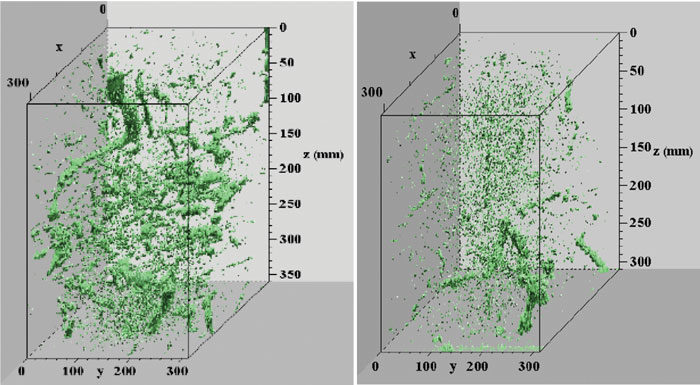No-Till Farmer
Get full access NOW to the most comprehensive, powerful and easy-to-use online resource for no-tillage practices. Just one good idea will pay for your subscription hundreds of times over.

COMPACTION IMPACT. The green dots in these two charts illustrate soil porosity. The larger masses of green are macro pores that encourage infiltration during rainfall. The chart on the left is a field before it was trafficked, and the chart on the right shows compaction after applying a 35-psi load, the typical pressure of a wheeled grain cart.
No-tillers can turn new technology into an asset if they’re prepared for advancements coming in the not-so-distant future.
That’s the opinion of Scott Shearer, chair of the department of food, agricultural and biological engineering at Ohio State University, who shared his predictions at the 2022 National No-Tillage Conference about how autonomous farm machinery will change the structure of the agriculture industry. He sees autonomy as a solution to some of farmers’ biggest issues, including labor shortages and compaction.
“Producers have got to be really good at 12-14 different things,” Shearer says. “With the onslaught of technology, can you continue to be good at those 12-14 different things? In some cases, I think there could be some justification for a different approach toward technology.”
Farm equipment keeps increasing in size. Recently, Fendt introduced the 790-hp IDEAL combine — “a heck of a bean machine” Shearer says. John Deere’s X9 1000 combine has 630 hp, Unverferth is building 2,500 bushel grain carts, and other equipment manufacturers continue to bring heavy equipment to market.
Shearer says the “tractor size conundrum” drives the potentially endless path of bigger, heavier equipment. Manufacturers tell Shearer they’re building big tractors because farmers buy them, and farmers say they buy big tractors because manufacturers build them.
There’s more to it than that, as farmers are buying big equipment to work faster, but it still comes at a cost to the soil.
“One of the reasons our infiltration rates suffer right now is because of equipment…